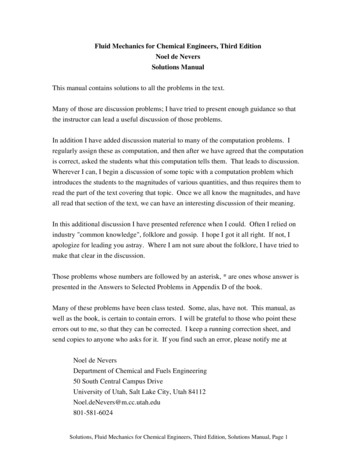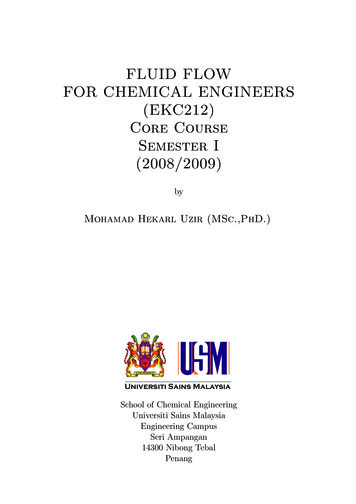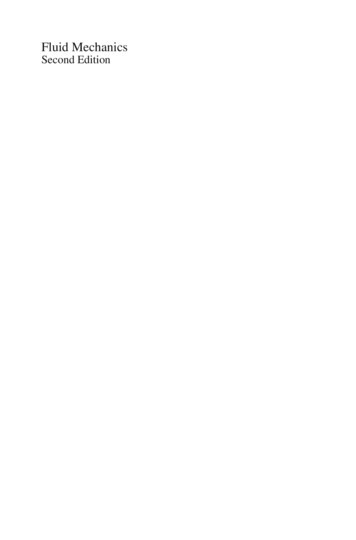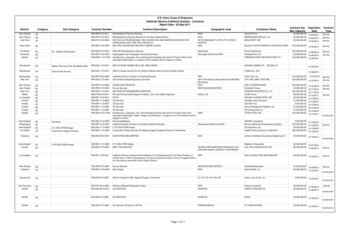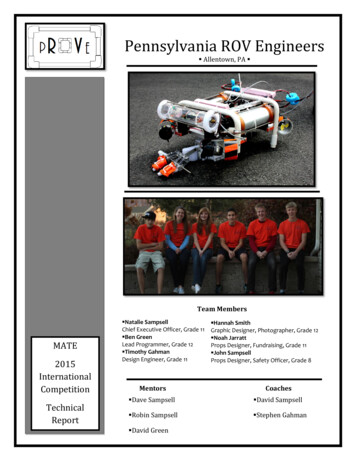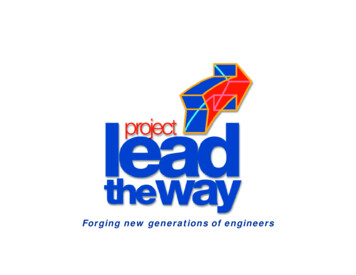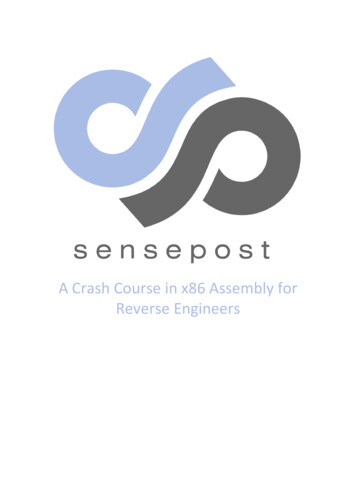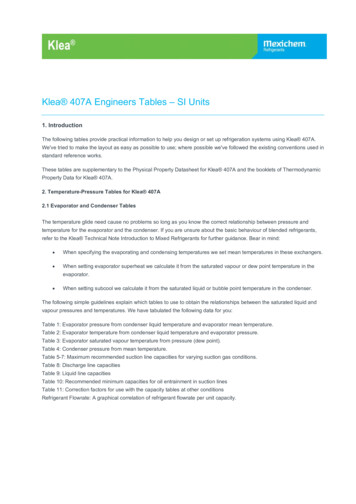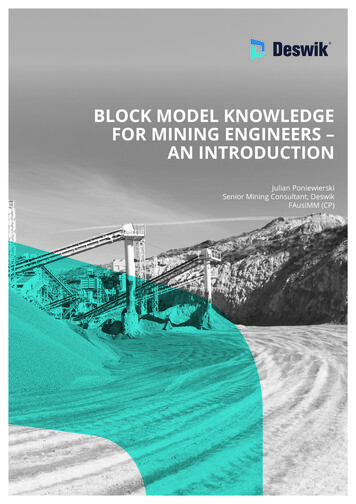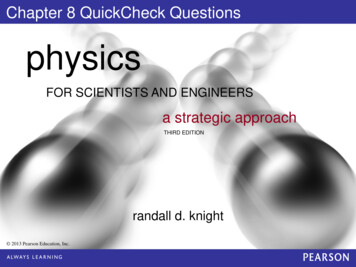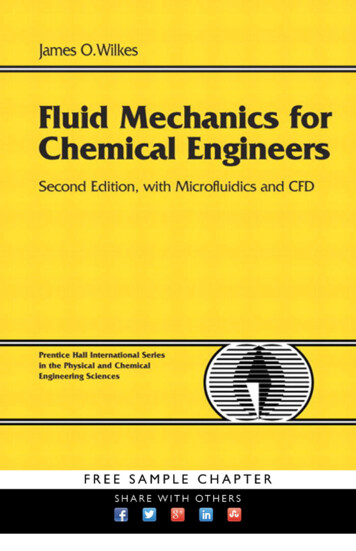
Transcription
Fluid Mechanics forChemical EngineersSecond Editionwith Microfluidics and CFD
Prentice Hall International Series in thePhysical and Chemical Engineering SciencesVisit informit.com /ph /physandchemfor a complete list of available publications.The Prentice Hall International Series in the Physical andChemical Engineering Sciences had its auspicious beginning in1956 under the direction of Neal R. Amundsen. The series comprises themost widely adopted college textbooks and supplements for chemicalengineering education. Books in this series are written by the foremosteducators and researchers in the field of chemical engineering.
FLUID MECHANICS FORCHEMICAL ENGINEERSSecond Editionwith Microfluidics and CFDJAMES O. WILKESDepartment of Chemical EngineeringThe University of Michigan, Ann Arbor, MIwith contributions bySTACY G. BIRMINGHAM: Non-Newtonian FlowMechanical Engineering DepartmentGrove City College, PABRIAN J. KIRBY: MicrofluidicsSibley School of Mechanical and Aerospace EngineeringCornell University, Ithaca, NYCOMSOL (FEMLAB): Multiphysics ModelingCOMSOL, Inc., Burlington, MACHI-YANG CHENG: Computational Fluid Dynamics and FlowLabFluent, Inc., Lebanon, NHPrentice Hall Professional Technical ReferenceUpper Saddle River, NJ Boston Indianapolis San FranciscoNew York Toronto Montreal London Munich Paris MadridCapetown Sydney Tokyo Singapore Mexico City
Many of the designations used by manufacturers and sellers to distinguish their productsare claimed as trademarks. Where those designations appear in this book, and the publisher was aware of a trademark claim, the designations have been printed with initialcapital letters or in all capitals.The author and publisher have taken care in the preparation of this book, but makeno expressed or implied warranty of any kind and assume no responsibility for errors oromissions. No liability is assumed for incidental or consequential damages in connectionwith or arising out of the use of the information or programs contained herein.The publisher offers excellent discounts on this book when ordered in quantity for bulkpurchases or special sales, which may include electronic versions and/or custom coversand content particular to your business, training goals, marketing focus, and brandinginterests.For more information, please contact:U.S. Corporate and Government Sales(800) 382–3419corpsales@pearsontechgroup.comFor sales outside the U.S., please contact:International Salesinternational@pearsoned.comVisit us on the Web: www.phptr.comLibrary of Congress Cataloging-in-Publication DataWilkes, James O.Fluid mechanics for chemical engineers, 2nd ed., with microfluidicsand CFD/James O. Wilkes.p. cm.Includes bibliographical references and index.ISBN 0–13–148212–2 (alk. paper)1. Chemical processes. 2. Fluid dynamics. I. Title.TP155.7.W55 2006660’.29–dc222005017816c 2006 Pearson Education, Inc.Copyright All rights reserved. Printed in the United States of America. This publication is protectedby copyright, and permission must be obtained from the publisher prior to any prohibitedreproduction, storage in a retrieval system, or transmission in any form or by any means,electronic, mechanical, photocopying, recording, or likewise. For information regardingpermissions, write to:Pearson Education, Inc.Rights and Contracts DepartmentOne Lake StreetUpper Saddle River, NJ 07458ISBN 0-13-148212-2Text printed in the United States on recycled paper at Courier Westford in Westford, Massachusetts8th PrintingOctober 2012.
Dedicated to the memory ofTerence Robert Corelli FoxShell Professor of Chemical EngineeringUniversity of Cambridge, 1946–1959
This page intentionally left blank
CONTENTSPREFACExvPART I—MACROSCOPIC FLUID MECHANICSCHAPTER 1—INTRODUCTION TO FLUID MECHANICS1.11.21.31.41.51.61.7Fluid Mechanics in Chemical EngineeringGeneral Concepts of a FluidStresses, Pressure, Velocity, and the Basic LawsPhysical Properties—Density, Viscosity, and Surface TensionUnits and Systems of UnitsExample 1.1—Units ConversionExample 1.2—Mass of Air in a RoomHydrostaticsExample 1.3—Pressure in an Oil Storage TankExample 1.4—Multiple Fluid HydrostaticsExample 1.5—Pressure Variations in a GasExample 1.6—Hydrostatic Force on a Curved SurfaceExample 1.7—Application of Archimedes’ LawPressure Change Caused by RotationExample 1.8—Overflow from a Spinning ContainerProblems for Chapter 133510212425262930313537394042CHAPTER 2—MASS, ENERGY, AND MOMENTUM BALANCES2.12.22.32.42.52.6General Conservation LawsMass BalancesExample 2.1—Mass Balance for Tank EvacuationEnergy BalancesExample 2.2—Pumping n-PentaneBernoulli’s EquationApplications of Bernoulli’s EquationExample 2.3—Tank FillingMomentum BalancesExample 2.4—Impinging Jet of WaterExample 2.5—Velocity of Wave on WaterExample 2.6—Flow Measurement by a Rotametervii555758616567707678838489
Contentsviii2.7Pressure, Velocity, and Flow Rate MeasurementProblems for Chapter 29296CHAPTER 3—FLUID FRICTION IN PIPES3.13.23.33.43.53.63.73.8IntroductionLaminar FlowExample 3.1—Polymer Flow in a PipelineModels for Shear StressPiping and Pumping ProblemsExample 3.2—Unloading Oil from a TankerSpecified Flow Rate and DiameterExample 3.3—Unloading Oil from a TankerSpecified Diameter and Pressure DropExample 3.4—Unloading Oil from a TankerSpecified Flow Rate and Pressure DropExample 3.5—Unloading Oil from a TankerMiscellaneous Additional CalculationsFlow in Noncircular DuctsExample 3.6—Flow in an Irrigation DitchCompressible Gas Flow in PipelinesCompressible Flow in NozzlesComplex Piping SystemsExample 3.7—Solution of a Piping/Pumping ProblemProblems for Chapter HAPTER 4—FLOW IN CHEMICAL ENGINEERING onPumps and CompressorsExample 4.1—Pumps in Series and ParallelDrag Force on Solid Particles in FluidsExample 4.2—Manufacture of Lead ShotFlow Through Packed BedsExample 4.3—Pressure Drop in a Packed-Bed ReactorFiltrationFluidizationDynamics of a Bubble-Cap Distillation ColumnCyclone SeparatorsSedimentationDimensional AnalysisExample 4.4—Thickness of the Laminar SublayerProblems for Chapter 4185188193194202204208210215216219222224229230
ContentsixPART II—MICROSCOPIC FLUID MECHANICSCHAPTER 5—DIFFERENTIAL EQUATIONS OF FLUID MECHANICS5.15.25.35.45.55.65.7Introduction to Vector AnalysisVector OperationsExample 5.1—The Gradient of a ScalarExample 5.2—The Divergence of a VectorExample 5.3—An Alternative to the DifferentialElementExample 5.4—The Curl of a VectorExample 5.5—The Laplacian of a ScalarOther Coordinate SystemsThe Convective DerivativeDifferential Mass BalanceExample 5.6—Physical Interpretation of the Net Rateof Mass OutflowExample 5.7—Alternative Derivation of the ContinuityEquationDifferential Momentum BalancesNewtonian Stress Components in Cartesian CoordinatesExample 5.8—Constant-Viscosity Momentum Balancesin Terms of Velocity GradientsExample 5.9—Vector Form of Variable-ViscosityMomentum BalanceProblems for Chapter 85CHAPTER 6—SOLUTION OF VISCOUS-FLOW PROBLEMS6.16.26.36.4IntroductionSolution of the Equations of Motion in RectangularCoordinatesExample 6.1—Flow Between Parallel PlatesAlternative Solution Using a Shell BalanceExample 6.2—Shell Balance for Flow Between ParallelPlatesExample 6.3—Film Flow on a Moving SubstrateExample 6.4—Transient Viscous Diffusion ofMomentum (COMSOL)Poiseuille and Couette Flows in Polymer ProcessingExample 6.5—The Single-Screw ExtruderExample 6.6—Flow Patterns in a Screw Extruder(COMSOL)292294294301301303307312313318
xContents6.56.6Solution of the Equations of Motion in CylindricalCoordinatesExample 6.7—Flow Through an Annular DieExample 6.8—Spinning a Polymeric FiberSolution of the Equations of Motion in SphericalCoordinatesExample 6.9—Analysis of a Cone-and-Plate RheometerProblems for Chapter 6322322325327328333CHAPTER 7—LAPLACE’S EQUATION, IRROTATIONAL ANDPOROUS-MEDIA onRotational and Irrotational FlowsExample 7.1—Forced and Free VorticesSteady Two-Dimensional Irrotational FlowPhysical Interpretation of the Stream FunctionExamples of Planar Irrotational FlowExample 7.2—Stagnation FlowExample 7.3—Combination of a Uniform Stream anda Line Sink (C)Example 7.4—Flow Patterns in a Lake (COMSOL)Axially Symmetric Irrotational FlowUniform Streams and Point SourcesDoublets and Flow Past a SphereSingle-Phase Flow in a Porous MediumExample 7.5—Underground Flow of WaterTwo-Phase Flow in Porous MediaWave Motion in Deep WaterProblems for Chapter 00CHAPTER 8—BOUNDARY-LAYER AND OTHER NEARLYUNIDIRECTIONAL FLOWS8.18.28.38.48.58.6IntroductionSimplified Treatment of Laminar Flow Past a Flat PlateExample 8.1—Flow in an Air Intake (C)Simplification of the Equations of MotionBlasius Solution for Boundary-Layer FlowTurbulent Boundary LayersExample 8.2—Laminar and Turbulent BoundaryLayers ComparedDimensional Analysis of the Boundary-Layer Problem414415420422425428429430
Contents8.78.88.98.10Boundary-Layer SeparationExample 8.3—Boundary-Layer Flow Between ParallelPlates (COMSOL Library)Example 8.4—Entrance Region for Laminar FlowBetween Flat PlatesThe Lubrication ApproximationExample 8.5—Flow in a Lubricated Bearing (COMSOL)Polymer Processing by CalenderingExample 8.6—Pressure Distribution in a CalenderedSheetThin Films and Surface TensionProblems for Chapter 8xi433435440442448450454456459CHAPTER 9—TURBULENT 4IntroductionExample 9.1—Numerical Illustration of a ReynoldsStress TermPhysical Interpretation of the Reynolds StressesMixing-Length TheoryDetermination of Eddy Kinematic Viscosity andMixing LengthVelocity Profiles Based on Mixing-Length TheoryExample 9.2—Investigation of the von KármánHypothesisThe Universal Velocity Profile for Smooth PipesFriction Factor in Terms of Reynolds Number for SmoothPipesExample 9.3—Expression for the Mean VelocityThickness of the Laminar SublayerVelocity Profiles and Friction Factor for Rough PipeBlasius-Type Law and the Power-Law Velocity ProfileA Correlation for the Reynolds StressesComputation of Turbulence by the k/ε MethodExample 9.4—Flow Through an Orifice Plate (COMSOL)Example 9.5—Turbulent Jet Flow (COMSOL)Analogies Between Momentum and Heat TransferExample 9.6—Evaluation of the Momentum/HeatTransfer AnalogiesTurbulent JetsProblems for Chapter 05509511513521
xiiContentsCHAPTER 10—BUBBLE MOTION, TWO-PHASE FLOW, roductionRise of Bubbles in Unconfined LiquidsExample 10.1—Rise Velocity of Single BubblesPressure Drop and Void Fraction in Horizontal PipesExample 10.2—Two-Phase Flow in a Horizontal PipeTwo-Phase Flow in Vertical PipesExample 10.3—Limits of Bubble FlowExample 10.4—Performance of a Gas-Lift PumpExample 10.5—Two-Phase Flow in a Vertical PipeFloodingIntroduction to FluidizationBubble MechanicsBubbles in Aggregatively Fluidized BedsExample 10.6—Fluidized Bed with Reaction (C)Problems for Chapter PTER 11—NON-NEWTONIAN �cation of Non-Newtonian FluidsConstitutive Equations for Inelastic Viscous FluidsExample 11.1—Pipe Flow of a Power-Law FluidExample 11.2—Pipe Flow of a Bingham PlasticExample 11.3—Non-Newtonian Flow in a Die(COMSOL Library)Constitutive Equations for Viscoelastic FluidsResponse to Oscillatory ShearCharacterization of the Rheological Properties of FluidsExample 11.4—Proof of the Rabinowitsch EquationExample 11.5—Working Equation for a CoaxialCylinder Rheometer: Newtonian FluidProblems for Chapter 11591592595600604606613620623624628630CHAPTER 12—MICROFLUIDICS AND ELECTROKINETICFLOW EFFECTS12.112.212.312.4IntroductionPhysics of Microscale Fluid MechanicsPressure-Driven Flow Through Microscale TubesExample 12.1—Calculation of Reynolds NumbersMixing, Transport, and Dispersion639640641641642
Contents12.512.612.712.812.9Species, Energy, and Charge TransportThe Electrical Double Layer and Electrokinetic PhenomenaExample 12.2—Relative Magnitudes of Electroosmoticand Pressure-Driven FlowsExample 12.3—Electroosmotic Flow Around a ParticleExample 12.4—Electroosmosis in a Microchannel(COMSOL)Example 12.5—Electroosmotic Switching in aBranched Microchannel (COMSOL)Measuring the Zeta PotentialExample 12.6—Magnitude of Typical StreamingPotentialsElectroviscosityParticle and Macromolecule Motion in Microfluidic ChannelsExample 12.7—Gravitational and Magnetic Settlingof Assay BeadsProblems for Chapter 12xiii644647648653653657659660661661662666CHAPTER 13—AN INTRODUCTION TO COMPUTATIONALFLUID DYNAMICS AND FLOWLAB13.113.213.313.4Introduction and MotivationNumerical MethodsLearning CFD by Using FlowLabPractical CFD ExamplesExample 13.1—Developing Flow in a PipeEntrance Region (FlowLab)Example 13.2—Pipe Flow Through a SuddenExpansion (FlowLab)Example 13.3—A Two-Dimensional Mixing Junction(FlowLab)Example 13.4—Flow Over a Cylinder (FlowLab)References for Chapter 13671673682686687690692696702CHAPTER 14—COMSOL (FEMLAB) MULTIPHYSICS FORSOLVING FLUID MECHANICS PROBLEMS14.114.214.314.4Introduction to COMSOLHow to Run COMSOLExample 14.1—Flow in a Porous Medium with anObstruction (COMSOL)Draw ModeSolution and Related Modes703705705719724
Contentsxiv14.5Fluid Mechanics Problems Solvable by COMSOLProblems for Chapter 14725730APPENDIX A:USEFUL MATHEMATICAL RELATIONSHIPS731APPENDIX B:ANSWERS TO THE TRUE/FALSE ASSERTIONS737APPENDIX C:SOME VECTOR AND TENSOR OPERATIONS740INDEX743THE AUTHORS753
PREFACETHIS text has evolved from a need for a single volume that embraces a widerange of topics in fluid mechanics. The material consists of two parts—fourchapters on macroscopic or relatively large-scale phenomena, followed by ten chapters on microscopic or relatively small-scale phenomena. Throughout, I have triedto keep in m
Fluid Mechanics for Chemical Engineers Second Edition with Microfluidics and CFD . The Prentice Hall International Series in the Physical and Chemical Engineering Sciences had its auspicious beginning in 1956 under the direction of Neal R. Amundsen. The series comprises the most widely adopted college textbooks and supplements for chemical engineering education. Books in this series
